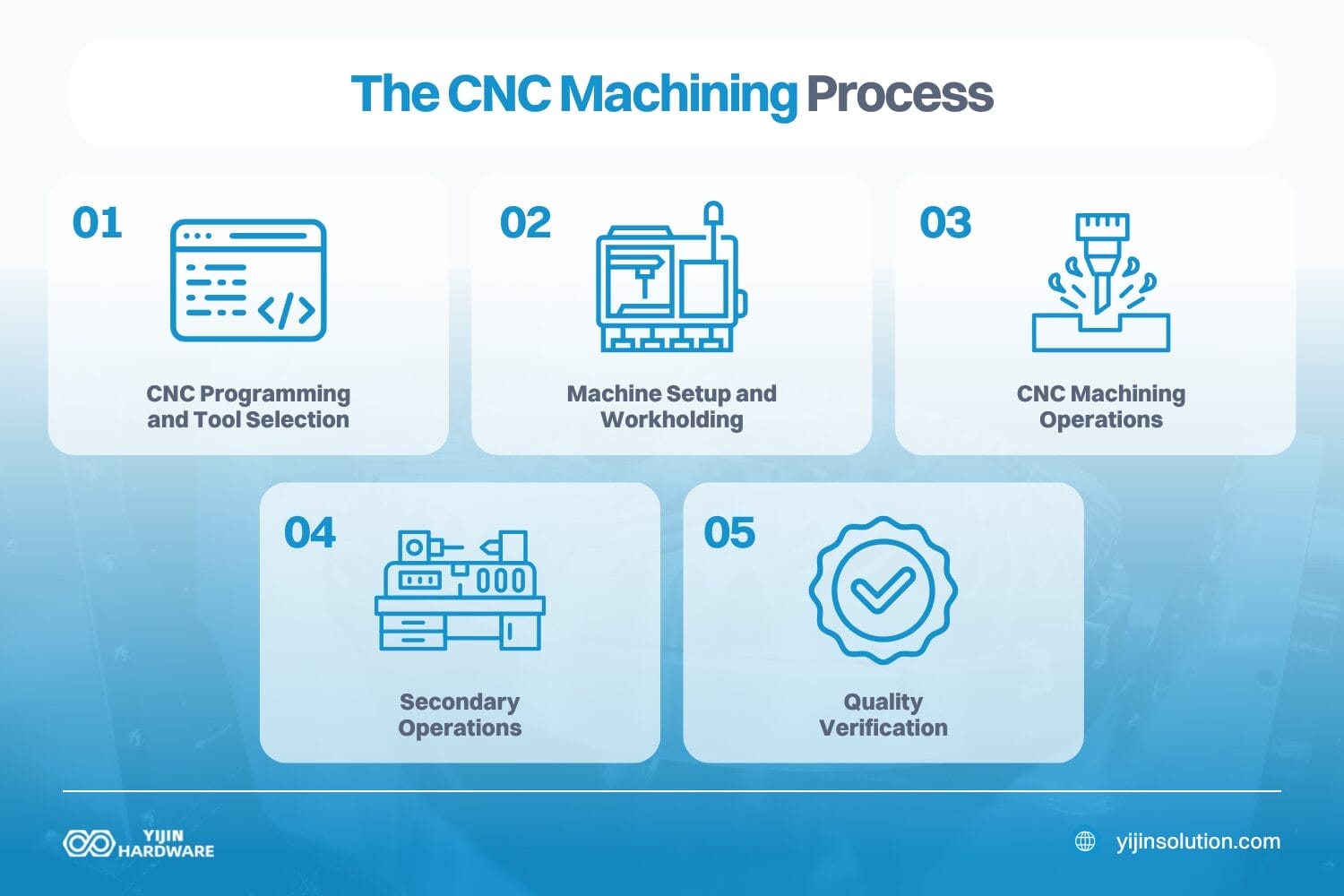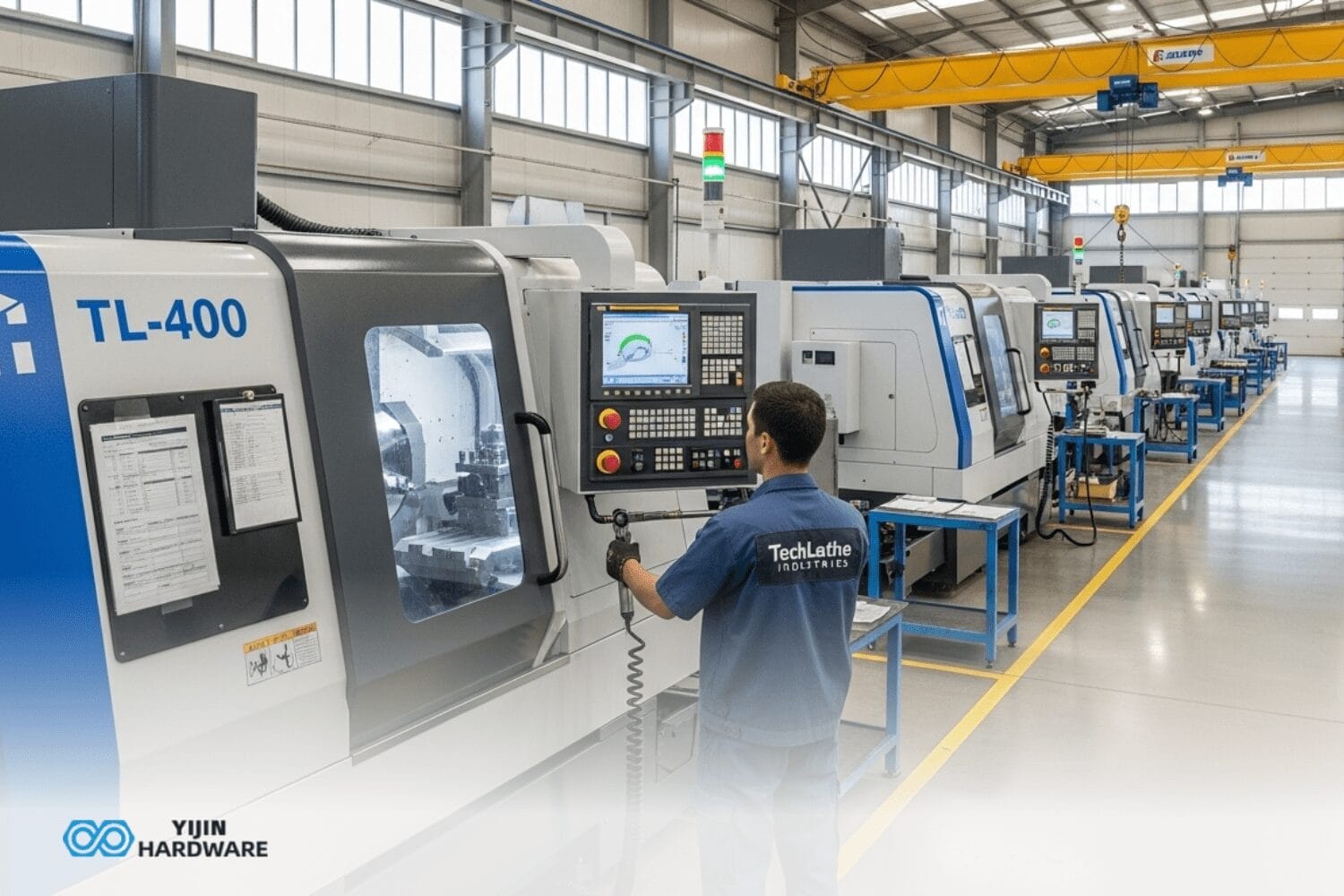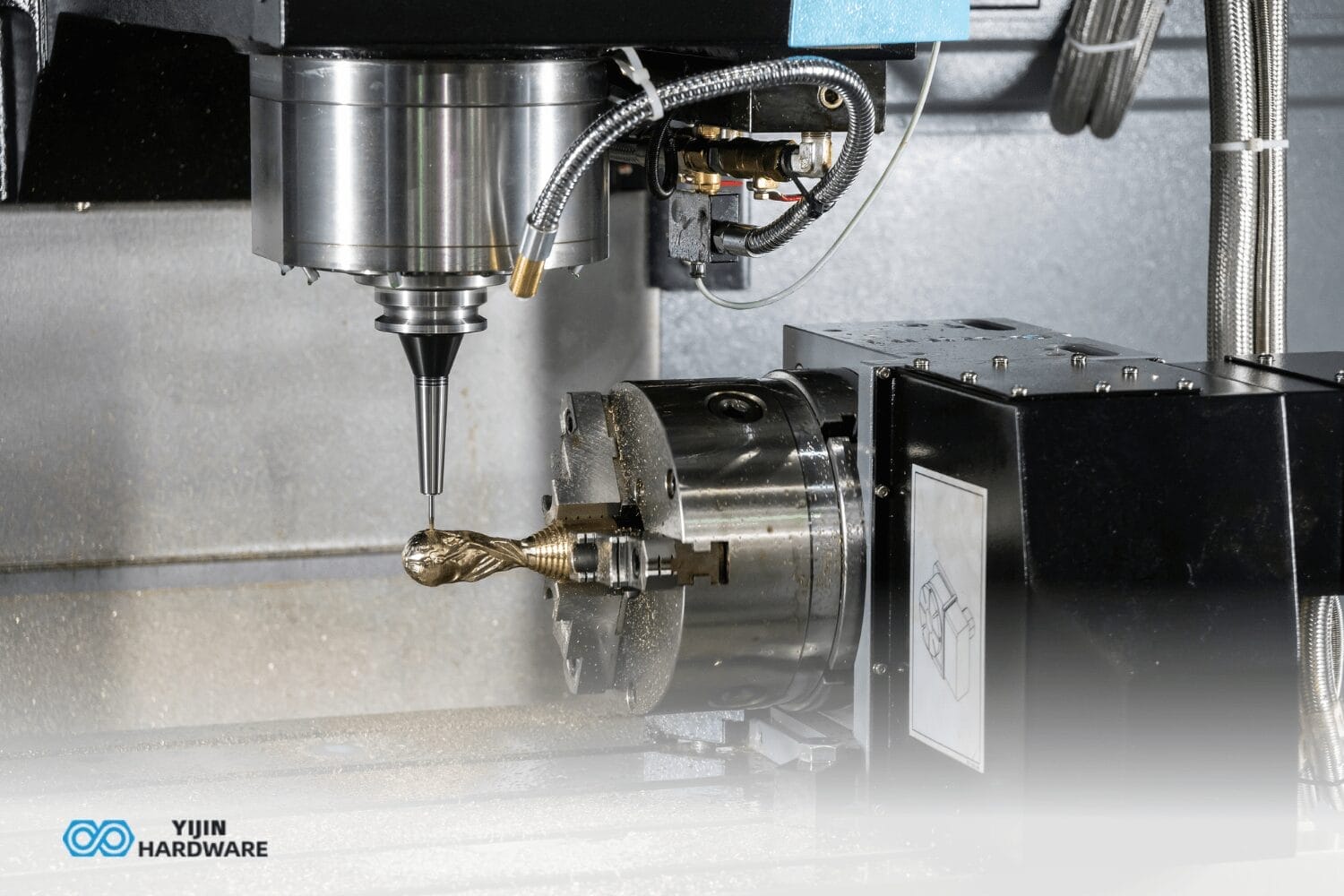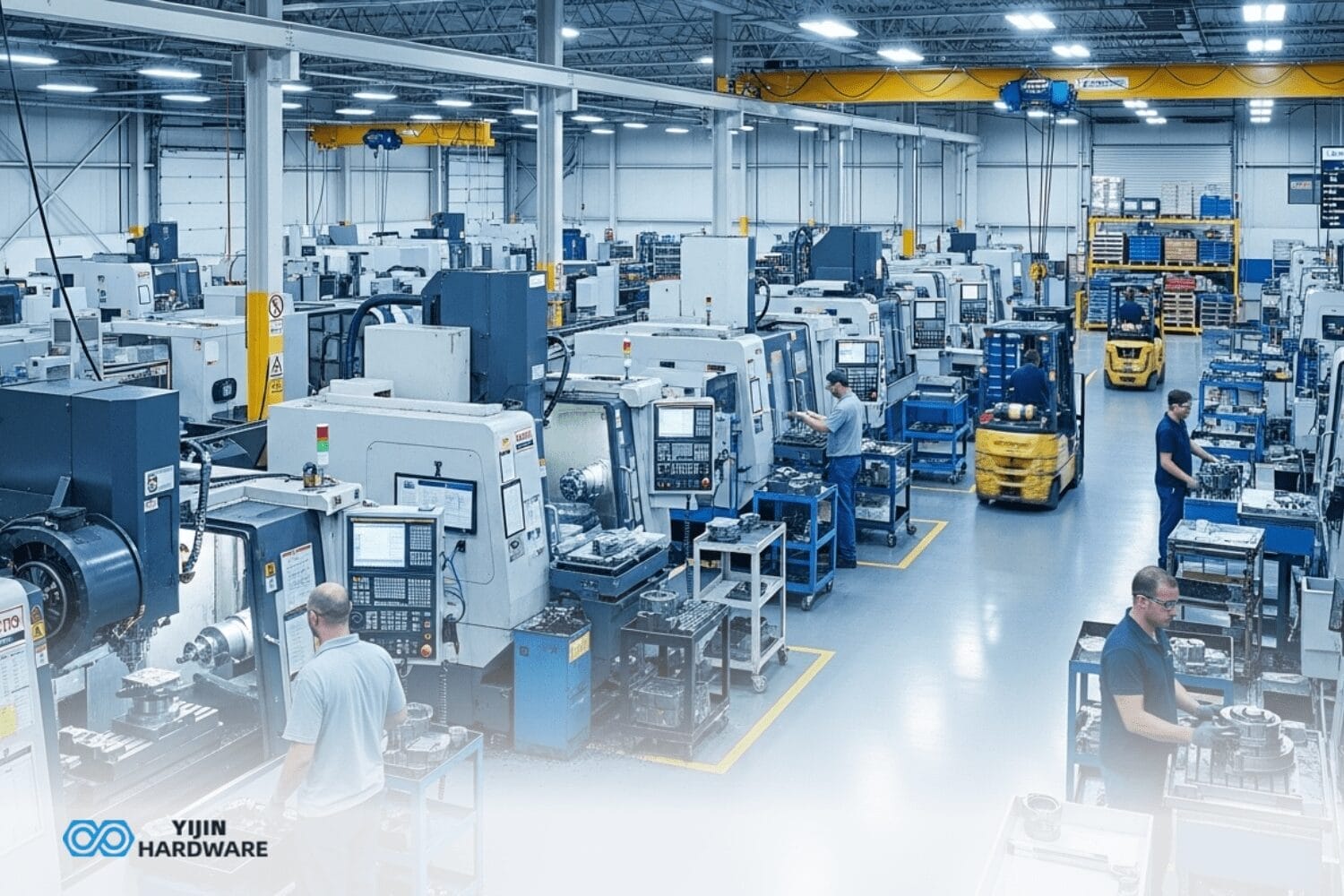Automotive CNC machining takes raw metal and transforms it into precision components through computer-controlled cutting, milling, and turning that hits the exact specs every single time. We’re talking about everything from engine blocks and transmission gears to suspension parts and EV battery housings – components where being off by even a fraction of a millimeter can mean the difference between a part that works and one that fails.
Yijin Hardware runs IATF 16949:2016-certified operations specifically for automotive work, machining custom parts with tolerances down to ±0.005 mm for OEMs, tier suppliers, and after market manufacturers. The reason CNC is non-negotiable in automotive is simple – manual machining just can’t deliver the repeatability you need for safety-critical components. These CNC machines run on G-code and M-code programming that controls cutting tools with micrometer-level precision, typically holding tolerances between ±0.005 mm and ±0.050 mm depending on what the application requires. With the global CNC machine market hitting $71.6 billion in 2025, a huge chunk of that growth is coming from automotive demand for everything from cylinder heads to brake calipers.
Key Takeaways
- Tolerances run from ±0.005 mm to ±0.050 mm because automotive parts can’t afford to be sloppy
- IATF 16949:2016 certification isn’t just paperwork – it proves you’re following actual automotive quality standards and defect prevention
- Multi-axis capabilities (3-axis, 4-axis, 5-axis machines) let you tackle complex geometries for engine, transmission, and chassis components
- Aluminum alloys like 6061-T6 and 7075-T6 are everywhere in automotive machining thanks to their strength-to-weight ratios
- Production flexibility goes from rapid prototypes done in 24 hours all the way up to runs over 100,000 pieces
What is Automotive CNC Machining?

Automotive CNC machining uses computer numerical control systems to automate the cutting, shaping, and finishing of vehicle components from metal and plastic stock materials. Modern CNC machines execute pre-programmed instructions written in G-code (geometric commands) and M-code (machine functions) to control cutting tool movements across multiple axes with precision down to 0.001 mm. This computer-controlled automation eliminates human error in repetitive operations while CNC machining allows for complex three-dimensional geometries impossible to achieve through manual methods.
The integration of CNC technology enables automotive manufacturers to produce parts with consistent quality across production runs. Engineers create CAD (Computer-Aided Design) models in software like SolidWorks or AutoCAD, then convert these 3D models into CAM (Computer-Aided Manufacturing) programs that generate the specific G-code instructions controlling tool paths, cutting speeds, and feed rates. The types of CNC machines used in automotive manufacturing range from 3-axis mills for simple operations to 5-axis machining centers capable of approaching workpieces from multiple angles without repositioning.
CNC Machine Types and Capabilities
| CNC Machine Type | Axis Movement | Typical Applications | Tolerance Range |
|---|---|---|---|
| 3-Axis Milling | X, Y, Z linear | Brackets, mounting plates, simple housings | ±0.025 mm — ±0.050 mm |
| 4-Axis Machining | X, Y, Z + rotational | Shafts, cylindrical parts, curved surfaces | ±0.015 mm — ±0.025 mm |
| 5-Axis Machining | X, Y, Z + 2 rotational | Complex engine parts, turbine housings, molds | ±0.005 mm — ±0.015 mm |
| Swiss-Type Turning | Sliding headstock with live tooling | Precision fasteners, small shafts, pins | ±0.005 mm — ±0.010 mm |
CNC machines ensure repeatability across thousands of identical components with statistical process control. A properly programmed CNC machine produces the 10,000th component with the same dimensional accuracy as the first piece, critical for assembly line operations where parts must interchange without custom fitting.
Why does Automotive Manufacturing Depend on CNC Machining?
Machining in the automotive industry has become essential because safety-critical components like brake calipers, steering knuckles, and engine connecting rods require dimensional accuracy and structural integrity that manual methods cannot guarantee at production volumes. CNC machining allows automated production that reduces manufacturing cycle times by 50-70% compared to conventional approaches, while eliminating the variability introduced by operator fatigue or skill differences. Modern automotive designers and engineers incorporate complex geometries for weight reduction and aerodynamic optimization that only multi-axis CNC equipment can manufacture economically.
Critical Precision Requirements
Precision machining plays a pivotal role in engine component manufacturing:
- Cylinder heads require flatness tolerances within 0.025 mm across sealing surfaces to prevent combustion gas leakage
- Piston ring grooves need dimensional accuracy of ±0.010 mm to maintain proper compression and oil control
- Crankshaft bearing journals demand concentricity within ±0.015 mm for bearing longevity
- Valve seats require surface finish below 0.8 μm Ra for proper sealing
The versatility of CNC machining enables automotive companies to iterate component designs rapidly without manufacturing new dies or jigs. CNC machining offers cost efficiency that accelerates development cycles from months to weeks. The precision of CNC technology enables electric vehicle battery housings, motor rotors, and thermal management components requiring lightweight aluminum construction with complex internal channels.
What Automotive Components are Manufactured with CNC Machining?
CNC machining is used to produce engine components including cylinder heads, engine blocks, crankshafts, camshafts, pistons, and connecting rods from aluminum alloys, cast iron, and forged steel. Transmission systems rely on CNC-machined gears, synchronizer rings, shift forks, and valve bodies requiring precise tooth profiles and bearing surfaces. Chassis and suspension components such as control arms, steering knuckles, tie rod ends, and subframe mounting brackets demand the structural integrity and dimensional accuracy that CNC milling and turning deliver.
Component Categories and Specifications
| Component Category | Common Parts | Typical Materials | Critical Tolerances |
|---|---|---|---|
| Engine | Cylinder heads, pistons, crankshafts, camshafts | Aluminum 356-T6, 4140 steel, ductile iron | ±0.010 mm — ±0.025 mm |
| Transmission | Gears, shafts, synchronizers, valve bodies | 8620 steel, 4140 steel, aluminum | ±0.005 mm — ±0.015 mm |
| Suspension | Control arms, knuckles, mounting brackets | 6061-T6 aluminum, 1018 steel | ±0.025 mm — ±0.050 mm |
| Brake Systems | Calipers, rotors, mounting hardware | 316 stainless steel, 6061 aluminum | ±0.015 mm — ±0.025 mm |
Electric Vehicle and Advanced Applications
Applications of CNC machining in the automotive sector have expanded with electric vehicle development:
- Battery housing components requiring lightweight aluminum construction with optimized thermal channels
- Motor end bells and gear reduction housings using 6061-T6 or 7075-T6 aluminum
- Cooling system manifolds where CNC machining is employed to create precise flow paths
- Charging port assemblies requiring precision features for electrical isolation
- Thermal interface plates with surface flatness tolerances within 0.050 mm
- High-voltage cable terminations machined from brass or copper alloys
CNC turning and CNC milling machines handle fuel system components including injection rails, pump housings, and throttle bodies to achieve internal passage tolerances and surface finishes necessary for proper fluid dynamics. Exhaust manifolds and catalytic converter housings benefit from cutting-edge CNC machining operations that create optimized flow paths while maintaining critical flange flatness.
How does the CNC Machining Process Work for Automotive Parts?

Using CNC machining techniques begins with engineering analysis where design teams review CAD models to identify critical dimensions, tolerance requirements, and optimal machining strategies. Design for Manufacturability (DFM) analysis evaluates part geometry to recommend modifications that improve machinability, reduce cycle time, or enhance dimensional stability—such as adding draft angles, increasing fillet radii, or optimizing wall thickness. Material selection considers factors including strength-to-weight ratio, thermal properties, corrosion resistance, and machining characteristics to balance performance requirements against manufacturing costs.
Manufacturing Process Steps
1. CNC Programming and Tool Selection
A CNC machining program converts approved CAD geometry into machine instructions by defining toolpaths, selecting appropriate cutting tools, and establishing machining parameters like spindle speeds and feed rates. Skilled CNC operators and programmers match insert geometries and cutting edge preparations to the workpiece material—carbide inserts with TiAlN coatings for aluminum, cermet tools for cast iron, and CBN (Cubic Boron Nitride) inserts for hardened steels.
2. Machine Setup and Workholding
Precise machining requires proper workpiece fixturing to resist cutting forces while maintaining accessibility for tool approaches. Technicians mount parts in vises, chuck jaws, or custom fixtures, then probe reference surfaces to establish coordinate systems. Tool length compensation and tool diameter offset measurements ensure cutting tools contact the workpiece at programmed positions.
3. CNC Machining Operations
CNC machines operate automatically once the operator initiates the program cycle. Spindle motors rotate cutting tools at speeds from 500 RPM for heavy roughing operations to 18,000 RPM for aluminum finishing passes. Servo motors drive linear axes at feed rates from 0.05 mm to 5.0 mm per tooth depending on operation type and material hardness, demonstrating how CNC machines excel at maintaining consistent parameters throughout production.
4. Secondary Operations
- Deburring removes sharp edges that could cause assembly difficulties
- Threading operations cut screw threads using taps, dies, or thread milling cutters
- Heat treatment processes like annealing or case-hardening modify material properties
- Surface finishing includes anodizing, electroplating, powder coating, or passivation
5. Quality Verification
Top-notch CNC machining services employ Coordinate Measuring Machines (CMM) to inspect critical dimensions against drawing specifications. CMM probes contact measurement points on the workpiece, calculating position coordinates with accuracy to 0.002 mm. First Article Inspection (FAI) documents complete dimensional verification before full-scale manufacturing begins. Production Part Approval Process (PPAP) compiles measurement data, material certifications, process flow diagrams, and control plans to demonstrate manufacturing capability following IATF 16949 requirements.
What Materials are Used in Automotive CNC Machining?
Aluminum alloys dominate machining for the automotive industry because their combination of low density (2.7 g/cm³), good machinability, and adequate strength makes them ideal for weight-sensitive components. 6061-T6 aluminum provides 310 MPa tensile strength with excellent corrosion resistance for engine mounts, transmission housings, and structural brackets. 7075-T6 aluminum delivers 572 MPa tensile strength approaching that of mild steel while weighing 65% less, making it suitable for high-stress suspension components and racing applications where advanced machining capabilities are essential.
Material Properties Comparison
| Material | Tensile Strength | Density | Thermal Conductivity | Typical Applications |
|---|---|---|---|---|
| Aluminum 6061-T6 | 310 MPa | 2.7 g/cm³ | 205 W/m·K | Brackets, housings, heat exchangers, battery enclosures |
| Aluminum 7075-T6 | 572 MPa | 2.8 g/cm³ | 130 W/m·K | High-stress suspension, racing components |
| 304 Stainless Steel | 515 MPa | 8.0 g/cm³ | 16 W/m·K | Exhaust manifolds, fuel system components |
| Titanium Ti-6Al-4V | 900 MPa | 4.4 g/cm³ | 7 W/m·K | High-performance engine parts, racing fasteners |
Steel and Stainless Steel Options
Stainless steel grades serve various automotive applications requiring corrosion resistance or high-temperature capability:
- 304 stainless steel offers good formability and weldability for exhaust components operating below 650 °C
- 316 stainless steel contains molybdenum for superior corrosion resistance in marine environments
- 17-4 PH stainless steel achieves 1,170 MPa tensile strength after precipitation hardening for high-stress fasteners
- 4140 chromium-molybdenum alloy steel reaches 655 MPa tensile strength in annealed condition, increasing to 1,570 MPa after heat treatment for crankshafts and connecting rods
- 8620 steel allows case-hardening through carburizing to create wear-resistant surfaces on transmission gears
Engineering Plastics
Engineering plastics provide lightweight alternatives for non-structural automotive parts:
- PEEK (Polyetheretherketone) withstands continuous temperatures to 260 °C for under-hood electrical connectors
- POM (Polyoxymethylene, Delrin) exhibits low friction coefficient and high wear resistance for gear applications and bushings
- ABS (Acrylonitrile Butadiene Styrene) offers impact resistance and aesthetic surface finish for interior trim
- Nylon 6/6 provides self-lubricating properties and chemical resistance for fuel system components
What Certifications are Required for Automotive CNC Machining?
IATF 16949:2016
- Follows three-year certification cycle with annual surveillance audits
- Requires compliance across ten clauses covering organizational context, leadership, planning, support, operation, performance evaluation, and improvement
- Mandates demonstration of process capability and continuous improvement
- Incorporates customer-specific requirements from major OEMs
ISO 9001:2015
- Provides foundation quality management system requirements
- Establishes basic requirements for quality policy, quality objectives, management review, process approach, and risk-based thinking
- Required as prerequisite for IATF 16949 registration
PPAP (Production Part Approval Process)
- Demonstrates manufacturing processes can consistently produce parts meeting design specifications
- Includes dimensional inspection results, material test reports, performance test results, process flow diagrams
- Incorporates Process Failure Mode Effects Analysis (PFMEA), control plans, and measurement system analysis (MSA) studies
- Five levels of submission, with Level 3 most common for production parts
Additional Quality Tools
- NADCAP accreditation for special processes like heat treating and non-destructive testing
- AS9100 aerospace quality standard adopted by automotive suppliers for high-reliability components
- NIMS (National Institute for Metalworking Skills) operator certifications improving workforce competence
Why Choose Yijin Hardware for Automotive CNC Machining?
Yijin Hardware operates IATF 16949:2016-certified manufacturing facilities with advanced machining capabilities including 3-axis, 4-axis, and 5-axis CNC machining centers capable of producing high-quality automotive components from prototype through high-volume production quantities. We machine aluminum alloys (6061-T6, 7075-T6, 2024, 5052), stainless steel grades (304, 316, 17-4 PH), titanium alloys (Ti-6Al-4V), and engineering plastics (PEEK, POM, ABS, Nylon) with standard tolerances of ±0.025 mm and ultra-precision capability to ±0.005 mm. Our CMM inspection equipment performs first article inspection, in-process verification, and final quality documentation following PPAP Level 3 requirements, ensuring CNC machined parts meet rigorous specifications.
Get Started with Professional Automotive CNC Machining Services
Ready to produce high-quality automotive components with precision CNC machining? Yijin Hardware delivers IATF 16949:2016-certified automotive CNC machining services for OEMs, tier suppliers, and aftermarket manufacturers worldwide. Our advanced CNC machining capabilities, multi-axis equipment, and comprehensive quality management systems ensure your automotive parts meet exact specifications from prototype through production. Contact our engineering team today to discuss your automotive machining needs, request a quote, or receive complimentary DFM analysis for your next project. Experience the precision, reliability, and technical expertise that makes Yijin Hardware your trusted partner for automotive CNC machined parts.
Automotive CNC Machining Services FAQs
What are the disadvantages of CNC machining in the automotive industry?
Initial programming and setup costs are high, making CNC less cost-effective for very simple parts compared to stamping or casting. CNC machining also wastes material since it removes large amounts as chips, and size limitations restrict the maximum workpiece dimensions.
What is the future of CNC machining in the automotive industry?
The future of CNC machining in the automotive industry is smart, automated, and sustainable, with the market projected to reach over USD 40 billion by 2030. Driven by electric and hybrid vehicle demand, it will integrate AI, robotics, and Industry 4.0 technologies for greater precision, efficiency, and flexibility, making CNC machining a core part of next-generation automotive manufacturing.
Will automotive CNC machining be replaced by AI?
AI improves CNC machining by optimizing toolpaths and adjusting parameters but cannot replace the physical cutting machines. CNC hardware remains essential for actual material removal, while AI enhances efficiency through smarter programming.
Back to Top: Automotive CNC Machining Services









